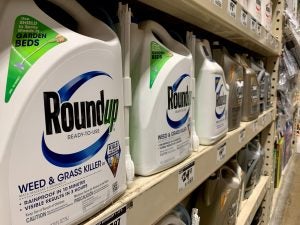A dangerous precedent. On June 3, 2020, a panel of three judges from the 9th U.S. Circuit Court of Appeals, based in San Francisco, vacated the registrations of three dicamba products intended for over-the-top application to soybeans and cotton genetically engineered to tolerate them. Years of work and hundreds of millions of dollars spent by seed and chemical companies to create a safe and effective control for weeds resistant to glyphosate was, by the stroke of a pen, destroyed.
Reaction was rapid. By June 5, nine agricultural organizations signed a letter to Andrew Wheeler, administrator of the U. S. Environmental Protection Agency, telling him the court’s decision was “devastating to our nation’s farmers and an affront to the regulatory system for pesticides established under the Federal Insecticide, Fungicide, and Rodenticide Act (FIFRA).” There is an established procedure for vacating a registration, but the court’s decree was not it. The EPA on June 8 partially complied, vacating the labels but allowed products already purchased to be used by July 31. Predictably, the plaintiffs objected, and on June 11 they requested the court hold the EPA in contempt. Then the EPA, on June 16, asked the court to deny the plaintiffs’ request.
In support of the EPA’s request, the American Farm Bureau and other national farm organizations filed a “friend of the court” brief outlining the tremendous damage a sudden label cancellation would do to soybean and cotton farmers who had seed in the ground and no viable alternative to the dicamba herbicides to control resistant weeds. Their brief also stated, “There is no emergency need for this court to undo EPA’s administrative order nor does this Court possess the authority to do so …”
On June 19, the judges ruled in favor of the Farm Bureau, et al, and denied the request to hold the EPA in contempt.
These products have been in the news a lot since their first use in 2015. Designed to be non-volatile, neighboring farmers nonetheless suffered extensive damage from dicamba volatility in 2017, perhaps from applicator mistakes and/or from off-label applications of ordinary dicamba, which has been on the market for decades and lacks the volatility restraints of the newer products. Application instructions were changed in 2018, but complaints continue. Hence the lawsuit by some farmers and environmental groups.
I cannot vouch for company claims of volatility control in their products, and I sympathize with farmers who have suffered damage. The court system is the place to settle damage disputes. But courts should not be able to vacate a pesticide registration — that took years of research and millions of dollars to accomplish — based on the selected science presented by plaintiffs and defendants. Courts should be able to demand reviews of a pesticide registration, and, if necessary, the orderly cancellation of a product. But what the 9th Circuit Court judges did set a dangerous precedent. Farmers have enough unknowables when they plant a crop — weather, prices, diseases, insects, and political meddling, to name a few. They don’t need the uncertainty of the availability of crop protectants when seed is put in the ground.
Since environmentalists were successful in getting a court to bypass — even briefly — the framework set up by Congress for the orderly cancellation of a pesticide, expect them to try this tactic again; probably with Roundup (glyphosate).

Roundup is also in the news with Bayer announcing it is setting aside $10 billion to $11 billion to settle claims that glyphosate causes cancer. They have reached agreement with lawyers representing about 100,000 claims, allotting those claims $9.6 billion. They had hoped to settle remaining and any future claims with a $1.25 billion fund to be allotted, according to rules determined by a panel of scientists who would study all research on the safety of Roundup and determine its probability of causing cancer. The panel would be made up of scientists acceptable to both sides. Bayer is betting such a panel would find glyphosate is not a carcinogen.
But District Judge Vince Chhabria said he was inclined to disallow such a solution and Bayer withdrew the proposal for now. Chhabria contends judges and juries should decide what science is correct. In my opinion, judges and juries are the problem when it comes to issues of science. They are generally not schooled in science, and they make decisions from limited facts using emotion and gut feelings.
Bayer will continue to insist Roundup does not cause cancer and will continue to market it. That is good news for farmers around the world who depend on Roundup applications to enable no-till practices, among other things. There really is no good substitute for glyphosate in no-till operations. And the fact that glyphosate has nearly eliminated erosion on approximately 1/3 of the tillable acres in the U.S. — plus millions of acres worldwide — while fostering practices that store soil carbon, seem totally lost on environmental organizations. Its safety to the environment and animals (including humans) is proven by thousands of experiments conducted over the last 45 years.
Sure, the International Agency for Research on Cancer (IARC) a few years ago labeled glyphosate as a “probable” carcinogen, and so far that has sparked about 125,000 lawsuits by individuals who claim it has caused their non-Hodgkin’s lymphoma. The IARC’s definition of a “probable” carcinogen includes working the night shift, working as a hairdresser, and eating barbecued meat. The IARC’s conclusions contradict safety reviews by government environmental agencies in Europe, the Americas, and Australia. A federal judge (Judge William B. Shubb) for the Eastern District of California recently ruled that California’s intent to require glyphosate labels to state “known to the State to cause cancer” under Proposition 65 rules is illegal, because it is a “misleading statement.” He states “virtually all … government agencies and health organizations that have reviewed studies on [glyphosate] have found there was no evidence that it caused cancer.”
The widespread use of glyphosate coupled with the modern ability to detect concentrations in parts per billion or smaller means glyphosate can be detected almost everywhere in air, water, and soil. Detection doesn’t necessarily mean dangerous. Spores of dangerous molds can be detected almost everywhere too, but we don’t fret about that. Unlike the infamous pesticide DDT that refuses to go away in the environment and is stored in the fat of most of our bodies, glyphosate breaks down quite rapidly in all environments, and any molecules we eat are quickly excreted. Claims that a few molecules of glyphosate passing through our digestive system has any measurable effect on the trillions of bacteria in the human gut are just that: claims.
Jack DeWitt is a farmer-agronomist with farming experience that spans the decades since the end of horse farming to the age of GPS and precision farming. He recounts all and predicts how we can have a future world with abundant food in his book “World Food Unlimited.” A version of this article was republished from Agri-Times Northwest with permission.



